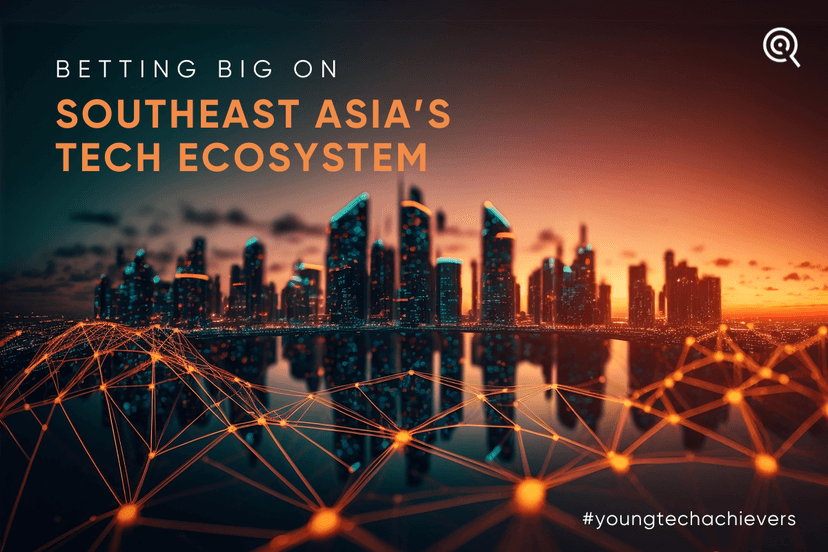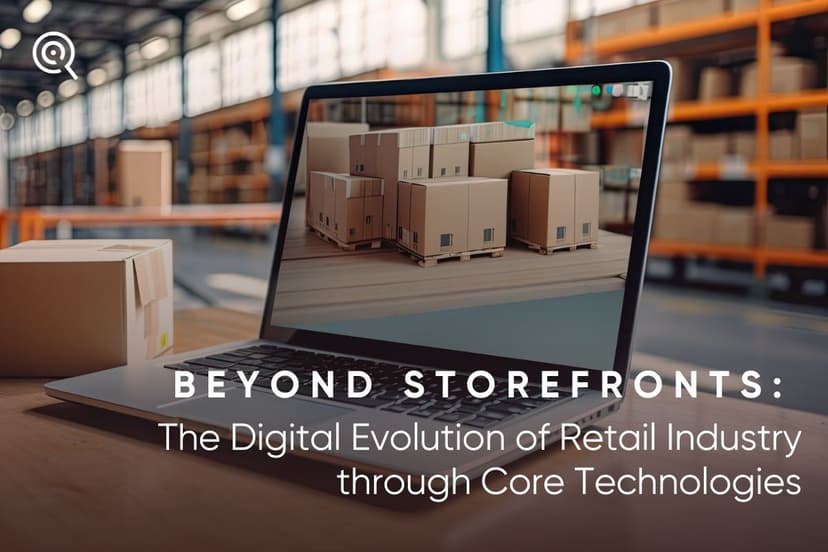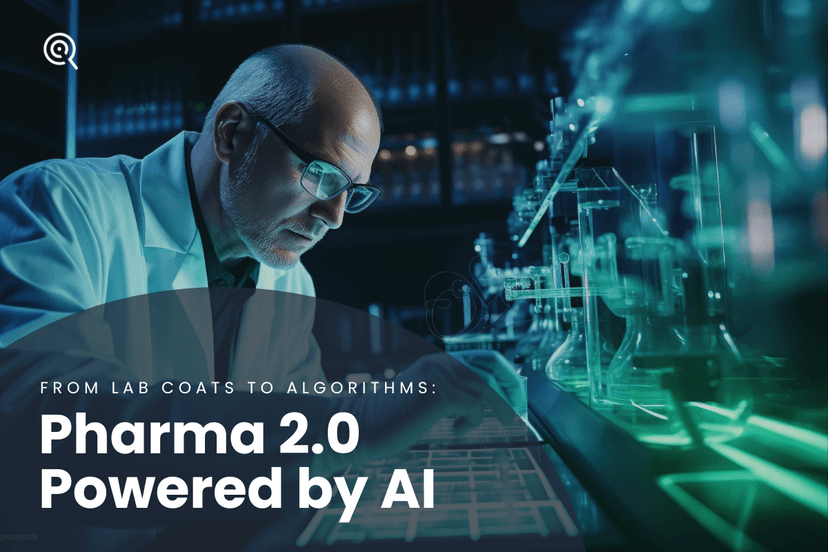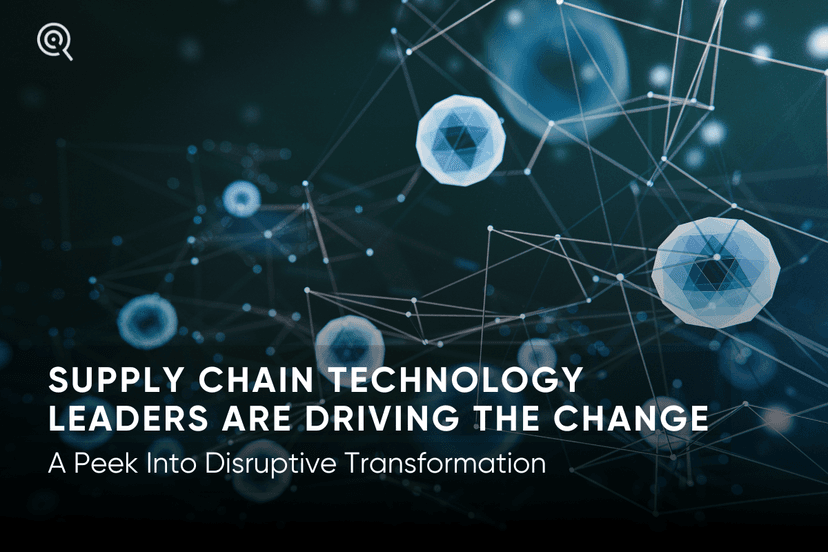Subscribe to Our Newsletter
Receive exclusive updates and insights directly in your inbox.
Receive exclusive updates and insights directly in your inbox.

<p>Southeast Asia is transforming into a hotbed for budding tech talents. According to Google & Temasek's e-Conomy SEA 2023 Report, in 2023, the SEA digital economy delivered $100 billion in revenue, growing at a 27% CAGR since 2021. </p> <p>With over 60% of the population under 35, considerable government and private support, and advanced tech resources, the region is fertile ground for aspiring technology professionals.</p> <h2><b>SEA’s Rise as a Tech Hub </b></h2> <h3><b>1. Government & Private Initiatives:</b></h3> <b>Singapore’s Smart Nation Initiative – </b>This is a holistic initiative thriving upon 3 key pillars – digital society, digital economy, and digital government. The Digital Readiness Blueprint highlights how the Singapore Government focuses on making technology more accessible to every Singaporean and helps local communities and businesses drive widespread adoption of technologies. <b>Indonesia’s 1000 Digital Startup Program – </b>With a vision to become the Digital Energy of Asia, this movement is a collaboration between government institutions, business firms, and education centers that provide semi-structured incubation activities for students to build technology startups that have a huge impact on society. Alongside these, various <b>government initiatives,</b> such as coding boot camps, startup incubators, and tax breaks, attract tech investments and nurture local talent. Several <b>private initiatives </b>are also encouraging young techies to pursue entrepreneurship. For instance, <b>Google for Startups Accelerator: Southeast Asia</b> is a 3-month equity-free program for Seed to Series A startups. This Accelerator program aims to support and accelerate top Southeast Asia startups via in-person and virtual activities, 1:1 mentoring, and group learning sessions. <b>Microsoft </b><b>Imagine Cup: SEA New Markets Edition</b> offers students the opportunity to tap into their entrepreneurial side and develop a technology solution to address some of today’s most pressing local and global issues. Students can gain new skills, connect with like-minded people, access exclusive training, avail of mentorship, have a chance to win great prizes and make a difference in the world.<b></b> <h3><b>2. Rising Economic Curve </b><b></b></h3> <p>While the funding landscape hit a rock throughout 2022 and ’23, Southeast Asia is expected to be better positioned this year. The Asian Development Bank projects the region’s GDP to expand by 4.7% this year, up from 4.3% in 2023. In line with these projections, analysts from Nomura Global Research expect ASEAN-5 countries—Indonesia, Malaysia, the Philippines, Singapore, and Thailand—to grow by an aggregate rate of 4.5% in 2024, compared to 3.9% last year.</p> <p>Alongside E-commerce and Fintech, sectors that could see the next wave of investment opportunities this year include AgriTech, Artificial Intelligence, ClimateTech, D2C brands, HealthTech, and Travel.</p> <p><br style="font-weight: 400;"><img class="alignnone size-large wp-image-148779" src="https://admin.purplequarter.com/storage/posts/67fe30426f883-Southeast-Asias-Rise-as-a-Thriving-Tech-Ecosystem-1024x683.png" alt="Southeast Asia's GDP forecast" width="1024" height="683"></p> <h3><b>3. Cost-Effectiveness</b> </h3> <p>Comparatively lower operating costs in Southeast Asia as opposed to Silicon Valley or Europe is a gateway for many businesses. Further, many Southeast Asian governments offer tax breaks and other incentives to attract foreign tech companies. </p> <p>This cost advantage is not just about less rent and a competitive salary; it also fosters agility, scalability, and sustainable growth by reinvesting savings into innovation and talent acquisition. </p> <h2><b>Promising Hubs </b></h2> <b>Singapore's Budget 2024</b> addresses critical areas for businesses, such as tackling rising costs, enhancing competitive advantages, and prioritizing sustainability. A newly announced <b>Enterprise Support Package</b> seeks to offer financial relief to businesses experiencing hikes in wage bills, rental, and utility expenses. With a commitment of SG$1.3 billion, this package provides support through the following three measures: <p><img class="alignnone size-large wp-image-148780" src="https://admin.purplequarter.com/storage/posts/67fe30458491b-Singapore-1024x683.png" alt="Singapore budget 2024 highlights" width="1024" height="683"></p> <b>Indonesia</b> is embarking on a transformative journey with<b> Visi Indonesia Digital 2045</b> – a multi-pronged strategy that concentrates on sector-wise focus (financial services, trade, retail, manufacturing, agriculture, and maritime), enhanced digital infrastructure and digital talent development, smart applications, economic impact and investment, regulatory framework and digital governance, and national digital strategy. <b>Thailand</b>’s Ministry of Digital Economy and Society has also announced a plan for 2024 to propel the nation’s digital transformation and elevate its competitive edge. Some of its key initiatives include: <p><img class="alignnone size-large wp-image-148781" src="https://admin.purplequarter.com/storage/posts/67fe3048a3240-Thailand-1024x683.png" alt="Thailand's digital transformation plan 2024" width="1024" height="683"></p> Further, in 2023, <b>Vietnam’s</b> burgeoning digital technology sector witnessed a meteoric rise in revenue, totalling an impressive US$142 billion, with the nation contributing an impressive 28.7% to the global digital technology market. <p>With unicorns like Grab and Sea Group & leading firms like Gojek, Tokopedia, and Tiki offering unparalleled infrastructure, resources, and talent pool – Southeast Asia boasts a combination of a tech-savvy population, supportive governments, and a booming business landscape that welcomes visionary leaders. </p> <h2><b>Spotlight on Young Techies in Southeast Asia</b></h2> <p><img class="alignnone size-large wp-image-148782" src="https://admin.purplequarter.com/storage/posts/67fe304ba6fb9-final-26-1024x299.png" alt="Spotlight on young techies in Southeast Asia " width="1024" height="299"><br style="font-weight: 400;"><br style="font-weight: 400;"></p> <h3><strong>1. Fransiska P.W. Hadiwidjana</strong></h3> <p>Engineer and entrepreneur, Fransiska Hadiwidjana is the Co-founder and CTO of WomenWorks – a women-first recruiting platform. Named among the top ten inspirational female tech entrepreneurs in Southeast Asia by Forbes, Fransiska has also founded Prelo – an Indonesia-based mobile e-commerce marketplace and co-founded AugMI labs – an award-winning biomedical startup in Silicon Valley. </p> <h3><strong>2. Gibran Huzaifah</strong></h3> <p>A fish farmer-turned-agriculture tech entrepreneur — eFishery founder and CEO Gibran Huzaifah is revolutionizing the relatively untapped $9.4 billion-valued Indonesian aquaculture market. Having started his own fish-rearing business back in his college days, he now owns one of the largest startups in the industry serving over 60,000 farmers and 280,000 ponds. </p> <h3><strong>3. Cyril Nie</strong></h3> <p>Cyril Nie is the co-founder and CTO of PixCap – a graphic design platform enabling users to create immersive digital experiences. Back in his college life, he received the Warwick Social Enterprise Award and the China Thinks Big Competition Award for ‘Plant for Planet'—an entrepreneurial solution towards environmental sustainability. </p> <h3><strong>4. Angelina Terlaki</strong></h3> <p>Angelina Terlaki is the co-founder of Red Dot Analytics, which pioneers cognitive digital twin solutions to digitalize, optimize and automate data center operations and management for business resilience and sustainability purposes. The Nanyang Technological University alumna is driven by the mission of using AI technologies to reduce carbon emissions. </p> <p> </p> <p>Southeast Asia's tech scene is a vibrant tapestry woven from passionate young talent, supportive governments, and a booming digital economy. With its cost-effectiveness, thriving startup ecosystem, and growing tech-savvy population, the region offers ample opportunities for aspiring tech professionals to launch their careers and make a global impact.</p> <p> </p> [<strong>Data Source:</strong> miscellaneous] <h4><br style="font-weight: 400;">Authored by Soumi Bhattacharya</h4> For more information, reach out to the <a href="marketing@purplequarter.com">Marketing Team</a> <p> </p>
Read More
<p>Remember when Iron Man blasts his way through a swarm of robots? Imagine if instead of repulsor rays, he whipped out a smartphone app to optimize crop yields for starving villages or deployed a fleet of drones to clean plastic from the ocean. Sounds less explosive, maybe, but just as heroic!</p> <p>That's the reality of tech for good, where innovation becomes a beacon of hope, tackling our planet's toughest challenges. No capes or spandex required (although, let's be honest, a cool tech suit wouldn't hurt). We're talking about everyday heroes armed with code, algorithms, and a whole lot of ingenuity, ready to reimagine the world. </p> <p>This week, we explore awe-inspiring tech titans bettering the planet with game-changing technology solutions. This is technology with a purpose, innovation with a heart, and a journey you won't want to miss.</p> <h2><b>DroneTech Powering Reforestation </b></h2> <p><img class="alignnone size-large wp-image-148498" src="https://admin.purplequarter.com/storage/posts/67fe304f4219f-4-1024x576.png" alt="Image" width="1024" height="576"></p> 25x faster than traditional manual seed planting is what Sydney-based <a href="https://airseedtech.com/">AirSeed Technologies</a>, an innovative environmental restoration company, claims to be doing in its aggressive fight against climate change. It is restoring natural forests affected by wildfires, logging, and flooding. The company has developed specialized seeding drones equipped with artificial intelligence capabilities to speed up and scale up the reforestation process. AirSeed’s drones are dropping up to 40,000 seed pods a day in remote, hazardous, inaccessible areas. Up north, a Canadian entity, <a href="https://flashforest.ca/">Flash Forest </a>is driven by a similar mission. Cameron and Bryce Jones were just 13 and 14 years old when they witnessed the Okanagan Mountain Park fire devastate their home city of Kelowna, British Columbia, in 2003. That destruction fueled an ambitious goal for the brothers: Plant one billion trees in Canada and across the world by 2028. Flash Forest deploys drones to shoot “seed pods” onto fire-damaged land to grow biodiverse, tree-rich landscapes. <h2><b>Education Evangelists: Technology Driving Blackboard Revolution</b></h2> <p><img class="alignnone size-large wp-image-148499" src="https://admin.purplequarter.com/storage/posts/67fe30526cd8e-5-1024x576.png" alt="Image" width="1024" height="576"></p> In 2013, <strong>Code.org</strong> was launched by twin brothers Hadi and Ali Partovi with a video promoting computer science. This video ranked #1 on YouTube and 15,000 schools reached out to us for help. This nonprofit organisation is dedicated to the vision that every student in every school has the opportunity to learn computer science as part of their core K-12 education. “In 1995, 37% of computer scientists were women. Today, it’s only 24%. The percent will continue to decline if we do nothing” — driven by this mission to close the gender gap in technology, <strong>Girls who Code</strong> has set out to build the world’s largest pipeline of female engineers. As many as 580,000 girls, women, and nonbinary individuals have entered the coding landscape through their in-person initiatives like the Summer Immersion Program, Clubs, and College Loops. <h2><b>A Future Powered by Green Innovation</b></h2> <p><img class="alignnone size-large wp-image-148500" src="https://admin.purplequarter.com/storage/posts/67fe30558bdea-6-1024x576.png" alt="Image" width="1024" height="576"></p> <p>As the climate crisis gets hotter than a dragon's breath, eco-champions armed with tech are on the frontlines!</p> Meet the real-life Aquamen! <strong>The Ocean Cleanup</strong> – a non-profit organization committed to cleaning up plastic-polluted seas and rivers. Their Interceptor solutions, powered by solar mechanics, smart processing, and connectivity, can map and collect plastic debris, leaving the oceans sparkling clean. California startup<strong> Aquacycl</strong> has developed the first commercially viable microbial fuel cell, a technology promising to revolutionize the treatment of water used in manufacturing. These fuel cells, called the BioElectrochemical Treatment Technology system (BETT), generate direct electricity from the bacteria already in the wastewater. Recently, Aquacyl has partnered with beverage giant PepsiCo to clean up the company’s industrial wastewater. This partnership will help the soft drink manufacturer cut up to 90% of its greenhouse gas emissions, eliminating 100 tons of greenhouse gas every month. <h2><b>Recycling Made Simpler with AI and Robotics</b></h2> <p><img class="alignnone size-large wp-image-148501" src="https://admin.purplequarter.com/storage/posts/67fe305918235-7-1024x576.png" alt="Image" width="1024" height="576"></p> <p>A study by National Geographic finds that the present trend of plastic usage will lead to 12 billion metric tons of plastic in landfills by 2050. That amount is 35,000 times as heavy as the Empire State Building. </p> <p>But wait! Enter the heroes of this trashy tale: AI-powered robot warriors armed with brainy vision systems and articulated arms. These new generations of trash-sorting robots are working alongside humans at recycling centers. AI-driven optical technology provides real-time data about waste-stream contaminants. These data can be used to steer manufacturers toward more recycling-friendly product designs. </p> With the mission to develop and operate innovative reuse, recycling, and zero-waste programs that improve the environmental quality of the community, <strong>Recycle Ann Arbor </strong>has installed a sorting robot from <strong>Machinex</strong> called the SamurAI. <strong>Glacier</strong>, on the other hand, is building a proprietary AI algorithm capable of recognizing over 90% of recyclables in the waste stream. These purpose-built, custom-made robots can use AI information to identify items, pick them up off of a moving conveyor belt, and sort them into the correct location. <h2><b>Building a Better Tomorrow, Byte by Byte</b></h2> <p>These are a few of the remarkable instances of how technology is reshaping the world for the better. From saving the planet to empowering people, the possibilities are endless. So, join the movement! Share these stories and support these initiatives to build a future where technology is recognized as the force for good and not merely limited to hyped gadgets and gizmos.</p> <p> </p> <h3>Authored by Soumi Bhattacharya</h3> For more information, please reach out to the <a href="https://www.purplequarter.com/the-power-of-self-awareness-in-building-true-blue-leaders/leadership-advisory/Marketing@purplequarter.com">Marketing Team.</a>
Read More
<!-- wp:paragraph --> <p>Traditionally viewed as a non-tech sector, retail is now at the forefront of a digital revolution, leveraging cutting-edge technologies to enhance customer experiences, streamline operations, and stay competitive in an increasingly dynamic market.</p> <!-- /wp:paragraph --> <!-- wp:paragraph --> <p>Advanced analytics and artificial intelligence (AI) are employed to analyze vast amounts of consumer behavior, predict trends, and offer tailored products and services. This not only enhances customer satisfaction but also establishes a competitive edge in the market.</p> <!-- /wp:paragraph --> <!-- wp:gallery {"linkTo":"none"} --> <figure class="wp-block-gallery has-nested-images columns-default is-cropped"><!-- wp:image {"id":148482,"sizeSlug":"large","linkDestination":"none"} --> <figure class="wp-block-image size-large"><img class="wp-image-148482" src="https://admin.purplequarter.com/storage/posts/67fe305ed9fc4-digital-wardrobe-transparent-screen-2-scaled.jpg" alt="Image"></figure> <!-- /wp:image --></figure> <!-- /wp:gallery --> <!-- wp:paragraph --> <p>Beyond customer interactions, advanced technologies significantly boost retail operations' efficiency. Automation tools like inventory management systems and supply chain optimization streamline processes, reducing errors and enhancing overall productivity. This efficiency allows retail teams to focus on strategic tasks like marketing, product improvement, and customer relationships.</p> <!-- /wp:paragraph --> <!-- wp:paragraph --> <p>Today, mobile apps, user-friendly websites, and secure payment gateways facilitate seamless online transactions, broadening the customer base and providing valuable data for targeted marketing. Technology overall has enabled businesses of all sizes to look beyond and expand their reach, even globally. And to augment technological advancements, the retail industry is increasingly turning to the tech talent pool.</p> <!-- /wp:paragraph --> <!-- wp:image {"id":148480,"sizeSlug":"full","linkDestination":"none"} --> <figure class="wp-block-image size-full"><img class="wp-image-148480" src="https://admin.purplequarter.com/storage/posts/67fe3071ddcd8-front-view-people-wearing-vr-glasses.jpg" alt="Image"></figure> <!-- /wp:image --> <!-- wp:paragraph --> <p>Technology leaders are playing pivotal roles in shaping the strategic direction of retail companies. These leaders are responsible for aligning technology initiatives with business goals, ensuring the successful implementation of digital strategies, and fostering a culture of innovation within their organizations.</p> <!-- /wp:paragraph --> <!-- wp:paragraph --> <p>One such retail company is San Francisco-based Quince, which offers multi-category fashion products for men and women. A unique direct-from-manufacturer business model that matches supply with demand in real-time by cutting out intermediaries in various ways.</p> <!-- /wp:paragraph --> <!-- wp:paragraph --> <p>To elevate their technological capabilities and reverse logistics system to handle scale and new business complexities, Quince wanted a dynamic and visionary tech leader. They strengthened their tech team by appointing Pradeep Mishra as the Director of Engineering. This tech leader would bring a strong product mindset, entrepreneurial spirit, and hands-on experience in transitioning from monolith to microservices. </p> <!-- /wp:paragraph --> <!-- wp:paragraph --> <p>Do you want to find the right tech leader for your organization? <a href="https://purplequarter.co" target="_blank" rel="noreferrer noopener">We are a step away</a>.</p> <!-- /wp:paragraph --> <!-- wp:paragraph --> <p> </p> <!-- /wp:paragraph --> <!-- wp:heading {"level":4} --> <h4 class="wp-block-heading">Authored by <strong>Nishka Agrawal</strong></h4> <!-- /wp:heading --> <!-- wp:paragraph --> <p>For more information, please reach out to the <a href="marketing@purplequarter.com" data-type="URL">Marketing Team.</a></p> <!-- /wp:paragraph -->
Read More
<p>Remember the days when drug discovery was a slow, arduous process of trial and error? Well, the pharmaceutical industry is ditching the age-old playbook and rewriting the rules of the game with AI!</p> <p>This isn't just some algorithm assistant filing paperwork. Think of AI as a super-powered lab assistant that can analyze mountains of data, whip up new drug candidates in record time, and even predict how well a treatment will work before you even take your first pill. Pretty mind-blowing, right?</p> <p>So buckle up, because we're about to dive into the intriguing domain of AI-powered pharmaceuticals. We'll explore how AI is revolutionizing everything, from drug discovery to clinical trials, and meet the tech titans leading the charge. </p> <h2><b>How exactly is AI changing the game? </b></h2> <p><ol></p> <p><li></p> <h3><b> Drug Discovery</b></h3> <p></li></p> <p></ol></p> <p>Imagine sifting through billions of molecules to find the perfect one to fight a disease. Sounds like a needle in a haystack, right? AI-driven approaches facilitate the screening of vast chemical libraries to identify potential drug candidates. Virtual screening, predictive modelling, and generative algorithms aid in designing novel compounds with specific therapeutic properties. This not only expedites the drug discovery process but also enhances the likelihood of identifying compounds with optimized efficacy and reduced side effects. </p> <p>A US-based biopharmaceutical company, BioXcel focuses on drug development, utilizing artificial intelligence to identify drug candidates across neuroscience and immuno-oncology. They leverage existing approved drugs and clinically evaluated product candidates, together with big data and machine learning algorithms, to identify new therapeutic applications.</p> <p>Google-owned AI research lab DeepMind has released an AI system — AlphaFold that predicts the 3D structure of a protein from its amino acid sequence and created the AlphaFold Protein Structure Database to share this knowledge with the scientific community. In 2022, the tool, which has billed itself as the “Google search for protein structures,” added more than 200 million new proteins to its growing database, providing a huge lift to scientists working in drug and vaccine discovery.</p> <p><ol start="2"></p> <p><li></p> <h3><b> Clinical Trials</b></h3> <p></li></p> <p></ol></p> <p>Forget the days of lengthy, expensive trials with thousands of participants. Predictive analytics and machine learning algorithms analyze patient data to identify suitable participants, predict patient responses, and optimize trial protocols. This saves time, money, and, most importantly, lives.</p> <p>Unlearn uses existing medical data to create digital twins (computer-created digital representations) of people that replicate patient variance and characteristics in clinical trials. By reducing control group sizes by up to 35% in phase 2 and 3 trials, the company’s tech allows drug companies to conduct smaller and faster product trials, potentially bringing life-saving medications to market at a much faster pace. Their solutions have been used in trials for neurodegenerative diseases including Alzheimer’s, Parkinson’s, and ALS. </p> <p><ol start="3"></p> <p><li></p> <h3><b> Personalized Medicine</b></h3> <p></li></p> <p></ol></p> <p>No more one-size-fits-all approach! AI can analyze your unique genetic makeup and medical history to predict how you'll react to different medications. This means doctors can prescribe treatments that are tailor-made for you, maximizing effectiveness and minimizing side effects. </p> <a href="https://www.brainomix.com/">Brainomix</a> specializes in the creation of AI-powered imaging biomarkers that enable precision medicine for better treatment decisions. They have rolled out varied AI imaging solutions for Interstitial Lung Disease (ILD), stroke, and solid tumor assessments. <p><ol start="4"></p> <p><li></p> <h3><b> Pharma’s AI-led RPA Boost</b></h3> <p></li></p> <p></ol></p> <p>Automating mundane, repetitive operations is one way that Robotic Process Automation (RPA) is revolutionizing the pharmaceutical industry. AI gives a cognitive boost to RPA (Robotic Process Automation). With AI’s pattern recognition and self-training algorithms, bots can automatically learn the best route through lab data, getting faster and more accurate over time. Also, AI-induced RPA systems can tackle intricate jobs like analyzing medical images or summarizing research papers, freeing human scientists for more strategic work.</p> <p>UiPath is leading the front by integrating AI into RPA to develop an effective healthcare system that meets the needs of both patients and healthcare professionals. With RPA's ability to handle routine tasks and AI's cognitive capabilities, they seek to streamline workflows, increase efficiency, and supercharge productivity. </p> Also, the USA-based startup <a href="https://strateos.com/robotic-cloud-lab/">Strateos</a> provides a robotic cloud lab to test out genetic engineering like sequencing, splicing, etc. Automating lab work accelerates scientific operations, freeing up time for analysis and boosting drug discovery scalability<b>.</b> <h2><b><img class="alignnone size-large wp-image-148452" src="https://admin.purplequarter.com/storage/posts/67fe307452ee8-doctor-from-future-concept_23-2151111164-1024x683.jpg" alt="AI in pharma " width="1024" height="683">Consideration of Ethical Implications</b></h2> As AI systems rely on vast datasets—patient information, genetic data, and clinical records—ensuring <b>robust data privacy</b> safeguards becomes paramount. Regulatory frameworks and industry standards are evolving to address these concerns, emphasizing the importance of transparency, informed consent, and secure data storage practices. If AI systems are trained on biased datasets, they may inadvertently perpetuate and amplify existing disparities in healthcare. This bias could manifest in various ways, from the underrepresentation of certain demographic groups in clinical trials to unequal access to innovative treatments. Addressing <b>bias in AI algorithms </b>is a multifaceted challenge that requires rigorous scrutiny of training data, algorithmic transparency, and ongoing monitoring. The rapid evolution of AI applications in drug discovery has outpaced the development of comprehensive regulatory frameworks. Regulatory agencies face the challenge of adapting existing guidelines to accommodate the unique features and complexities of AI-driven processes. To address this, there is a pressing need for international collaboration and the establishment of clear, <b>harmonized regulatory standards for AI </b>in healthcare. <p>Ethical considerations in drug development extend beyond scientific advancements, demanding a conscientious approach to ensure that AI technologies contribute to equitable healthcare outcomes. Striking a balance between innovation and ethical responsibility is crucial to harnessing the full potential of AI in healthcare, ensuring that the benefits of these technologies are accessible, equitable, and, above all, aligned with the highest standards of patient safety and well-being.</p> <p> </p> <p>The AI revolution in pharmaceuticals is still in its nascent stage, and the possibilities are truly endless. A future in which artificial intelligence (AI) assists with personalized treatment recommendations, disease prevention, and need prediction is something to look forward to.</p> <p> </p> <h4>Authored by Soumi Bhattacharya</h4> For more information, please reach out to the <a href="https://www.purplequarter.com/the-power-of-self-awareness-in-building-true-blue-leaders/leadership-advisory/Marketing@purplequarter.com">Marketing Team.</a> <p><br style="font-weight: 400;"><br style="font-weight: 400;"></p>
Read More
<p>The promise of a tech-first landscape is what Saudi Arabia projects with a multitude of strategic investments in technological innovation and digital transformation. The ICT sector is one of the fastest-growing sectors in the country, and it is expected to contribute 12.4% to GDP by 2030. With ongoing economic diversification and ventures in multiple sectors, the surge in demand for professionals in the technology sector is paramount. </p> <h2><b>Saudi Vision 2030 </b></h2> <p>Under the visionary leadership of Crown Prince Mohammed bin Salman, Saudi Arabia launched Vision 2030—a comprehensive blueprint to diversify the economy. Leveraging its strategic location and investment power, the government seeks to empower citizens and businesses to reach their full potential, diversify their economy, support local content, and create innovative growth opportunities. </p> <p>To reduce their dependence on oil, technology and digital transformation will play a pivotal role in this vision. As a result, the technology sector is witnessing remarkable growth, attracting both local and international investment.</p> <h2><b>Thriving Tech Start-up and IT Ecosystem </b></h2> <p>Saudi Arabia is nurturing a dynamic startup ecosystem with innovation hubs such as the King Abdullah University of Science and Technology (KAUST) and the King Abdulaziz City for Science and Technology (KACST), fostering research, development, and entrepreneurship and offering essential support and resources. These initiatives are building a strong ecosystem and creating lucrative job opportunities in AI, cybersecurity, data analytics, and software development.</p> <p>Furthermore, the implementation of Vision 2030 has led to the emergence of numerous IT companies. Among them, STC Solutions, the technology arm of Saudi Telecom Company (STC), a leading telecommunications operator in the Kingdom, stands out. It provides a comprehensive suite of IT solutions and services, encompassing cloud computing, cybersecurity, and digital transformation services.</p> <p>Other key players include SADAD Payment System, a fintech company offering advanced digital payment solutions; Cayan Group, a technology company specializing in innovative solutions across various sectors such as real estate, telecommunications, and information technology; and Elm, a digital solutions provider at the forefront of cutting-edge technologies, including artificial intelligence, blockchain, and cybersecurity. Together, these entities contribute significantly to Saudi Arabia's rapidly evolving tech landscape.</p> <h2><b>The Shift to Digital in Critical Sectors</b></h2> <p>Saudi Arabia is actively promoting digital transformation across key sectors, creating opportunities for technology professionals to contribute to its advancement. In the healthcare industry, there is a notable shift towards telemedicine, digital health records, and AI-driven diagnostics. Similarly, the financial sector is embracing fintech, mobile banking, and blockchain technologies. As these industries progress, the demand for experts in digital strategy, software engineering, data science, and cybersecurity is on the rise.</p> <p>The government has implemented various initiatives, such as the National Transformation Program (NTP) which focuses on specific economic and developmental sectors, including education, health, and finance, to create a sustainable environment conducive to digital solutions. Furthermore, the emerging tech hubs of Riyadh and Jeddah foster innovation, research, and development and attract both local and international talent, bolstering the digital landscape.</p> <h2><b>Hyper-Attention on Smart Cities and Infrastructure</b></h2> <p>Smart city projects have been launched in various cities, including Riyadh, Yanbu Industrial City, Makkah, Jeddah, Madinah, Al-Ahsa, and NEOM City. The market size of smart cities in Saudi Arabia reached $3,552.1 million in 2019 and is anticipated to grow to $14,745.2 million by 2027, with a compound annual growth rate (CAGR) of 19.6% from 2020 to 2027.</p> <p>Saudi Arabia's ambitious plans for smart cities and infrastructure development create significant opportunities for job growth in the technology sector. The flagship NEOM project aims to establish a forward-looking city powered by cutting-edge technology and sustainable practices. Additionally, major cities like Riyadh and Jeddah are investing in smart transportation, energy management systems, and Internet of Things (IoT) applications. Experts in Smart city planning, IoT architecture, energy management, and infrastructure cybersecurity are in high demand due to these endeavours.</p> <p>As a world logistics hub and rising industrial power, Saudi Arabia is drawing investment from all over. A case in point is the development of the Ceer electric vehicle brand through a collaboration between the Public Investment Fund (PIF) and Foxconn, which is expected to create approximately 30,000 jobs. Simultaneously, the formation of the Saudi Special Economic Zone in Riyadh gives multinational companies a strong incentive to set up their regional headquarters in the country. Several financial sector entities, including BlackRock, JP Morgan Chase, HSBC, and Citigroup, have recently entered or expanded their presence in Saudi Arabia. They are attracted by investment prospects in sectors aligned with Vision 2030, such as renewable energy and infrastructure.</p> <h2><b><img class="alignnone size-large wp-image-148418" src="https://admin.purplequarter.com/storage/posts/67fe3078e6d3e-glowing-skyscrapers-illuminate-crowded-city-streets-generated-by-ai_24640-87889-1024x585.jpg" alt="saudi arabia digital" width="1024" height="585">Focus on Tech Talent Development</b></h2> <p>Dedicated to cultivating its domestic talent in the technology sector, Saudi Arabia has undertaken strategic initiatives such as the Saudi Data and AI Authority (SDAIA) and the MiSK Academy. These programs aim to cultivate digital skills and entrepreneurial spirit among the country's youth. Through scholarships and training initiatives, the government ensures that local talent is well-prepared with essential skills to spearhead the nation's digital evolution. </p> <p>Further, the government is focused on aligning curriculum with the demands of the digital age. Emphasis on science, technology, engineering, and mathematics (STEM) disciplines starts at the grassroots level, ensuring a solid foundation for future technological innovators. Additionally, vocational training programs have been established to bridge the skills gap, providing practical, hands-on experiences that prepare students for careers in technology-driven industries. Also, to encourage excellence in technology-related fields, the government has instituted generous scholarship programs. </p> <h2><b>Future Outlook</b></h2> <p>The focus on artificial intelligence is expected to intensify, with Saudi Arabia aiming to lead in AI research and applications. This includes developments in machine learning, natural language processing, and the integration of AI into various industries for improved efficiency and decision-making. The fintech sector is poised for rapid expansion, driven by a supportive regulatory environment and increasing consumer demand for digital financial services. The continued integration of blockchain and digital payment solutions is expected to reshape the financial landscape. </p> <p>Further, Saudi Arabia's commitment to sustainability extends to innovation in renewable energy technologies. The development of solar and other clean energy solutions is likely to position the Kingdom as a leader in sustainable practices, contributing to global efforts to combat climate change.</p> <p> </p> <h3>Authored by Soumi Bhattacharya</h3> For more information, please reach out to the <a href="https://www.purplequarter.com/the-power-of-self-awareness-in-building-true-blue-leaders/leadership-advisory/Marketing@purplequarter.com">Marketing Team.</a>
Read More
<p>The supply chain industry has long been inflicted with legacy challenges that have stagnated the domain’s growth. Thankfully, new-age technologies are ushering in a new era by reimagining the industry with enhanced efficiency, seamless connectivity, and reduced cost. </p> <p>Today, supply chain technology leaders are in high demand, and as a leadership search firm, we are witnessing this trend firsthand. A close scrutiny of our clients’ problem statements reveals a remarkable shift in how these brands are reshaping the supply chain landscape. In this issue, we will find how tech titans are shaking things up with cutting-edge technologies, innovative approaches, and agile practices.</p> <h2><b>I. Key Challenges in the Supply Chain Industry</b></h2> Traditional supply chains have a labyrinth of suppliers, manufacturers, and distributors, which leads to a <b>lack of transparency, inefficiencies, and delays (delayed shipments, excess inventory, and suboptimal resource allocation)</b>. These bottlenecks invariably <b>inflate costs</b> and compromise the ability to meet the demands of an ever-accelerating market. Cross-border markets have expanded commerce but also presented a new set of challenges. <b>Tariffs</b>, <b>geopolitical uncertainties</b>, and <b>varying regulatory frameworks</b> create a volatile landscape when it comes to globalization, demanding adaptive strategies to ensure the uninterrupted flow of goods on a global scale. <h2><b>II. Technology Leaders as Tech Transformers </b></h2> <p>In the face of challenges, technology leaders are emerging as architects of change and innovation:</p> <p><ol></p> <li style="font-weight: 400;" aria-level="1"><b>Data Analytics and Predictive Modeling: </b>Harnessing the power of data analytics, tech leaders design custom platforms to tap the <b>real-time insights </b>of the movement of goods. From supplier to end consumer, this visibility allows for<b> timely actions</b> and <b>optimized decision-making</b>. Further, predictive modelling enables accurate <b>demand forecasting</b>. Leveraging historical data, market trends, and external factors to anticipate demand fluctuations, tech leaders can <b>reduce the risk overstocking or stockouts</b><span style="font-weight: 400;"> while streamlining the entire supply chain process.</span> </li> <li style="font-weight: 400;" aria-level="1"><b>Internet of Things (IoT) Integration: </b>By embedding smart sensors in equipment and shipments, technocrats enable real-time monitoring of conditions such as temperature, humidity, and location. This helps in <b>maintaining product quality</b> during transit and facilitates <b>predictive maintenance</b><span style="font-weight: 400;">, minimizing downtime.</span> </li> <li style="font-weight: 400;" aria-level="1"><b>Artificial Intelligence (AI) and Machine Learning (ML): </b>The supply chain sector has a medley of challenges, and AI implementation is a key marker for many tech teams and tech leaders solving for rapid processing of vast datasets, <b>streamlining decision-making</b>, <b>automating inventory management</b>, and <b>route optimization</b>. Advanced research asserts that Machine Learning algorithms learn and adapt from historical data, which can be harnessed to optimize supply chain operations continually. For instance, the Coca-Cola Company uses AI-powered algorithms to analyze historical sales data, weather patterns, and social media trends to adjust production and distribution in real-time, ensuring products are readily available when demands surge. <p></li></p> <li style="font-weight: 400;" aria-level="1"><b>Blockchain Technology:</b> Technology leaders leverage blockchain to create an immutable and transparent ledger of transactions. This enhances security and provides a clear view of the supply chain journey, <b>fostering trust and accountability</b>. For instance, Deoleo has collaborated with IBM for its Bertolli and Carapelli brands, utilizing IBM’s Food Trust blockchain-based QR code technology. By scanning the QR code, consumers can trace the olive oil's journey to confirm its origin and quality. Also, Blockchain's decentralized nature eliminates the need for intermediaries in transactions, <b>reducing delays</b> and <b>minimizing the risk of fraud</b><span style="font-weight: 400;">.</span> </li> <li style="font-weight: 400;" aria-level="1"><b>Robotics and Automation: </b>Capitalizing on Robotic Process Automation (RPA), technocrats are already <b>automating repetitive and labor-intensive </b>warehouse tasks. From picking and packing to inventory management, robotic systems <b>enhance speed and accuracy,</b> reducing operational costs and improving overall efficiency. New research and innovations are aimed at <b>integration of autonomous vehicles in logistics </b>to the transportation ecosystem. Tech leaders are exploring self-driving trucks and drones, optimizing delivery routes, reducing fuel consumption, and enhancing the reliability of deliveries.</li> <p></ol></p> <p><img class="alignnone size-large wp-image-148007" src="https://admin.purplequarter.com/storage/posts/67fe308f44e49-Blog-infographic-Benefits-of-Technological-Integration-into-Supply-Chain-Ecosystem-1024x576.png" alt="benefits of technology integration into supply chain ecosystem" width="1024" height="576"></p> <h2><b>III. Potential Challenges and Considerations</b></h2> <p>Navigating the path of supply chain digital transformation requires a keen awareness of potential hurdles to ensure a seamless and effective transition. From advanced technology integration to people management – tech leaders should have a multidimensional approach. For instance, integrating complex systems like AI, IoT, or blockchain into existing infrastructure while ensuring robust cybersecurity requires careful planning, skilled personnel, and a strategic and phased approach. Technology leaders should focus on upskilling or reskilling employees to operate and manage these new systems effectively. The fear of job displacement due to automation also requires thoughtful strategies, such as creating new roles focused on overseeing and optimizing automated processes.</p> <p>As we peek into the future of supply chain technology, the trajectory is clear—a future where agility, sustainability, and innovation are not just buzzwords but the cornerstones of a resilient and adaptive supply chain. And positioning an experienced technology leader at the helm is essential for supply chain companies to stay ahead of the competition.</p> <p> </p> <h3>Authored by Soumi Bhattacharya</h3> For more information, please reach out to the <a href="Marketing@purplequarter.com">Marketing Team.</a>
Read More